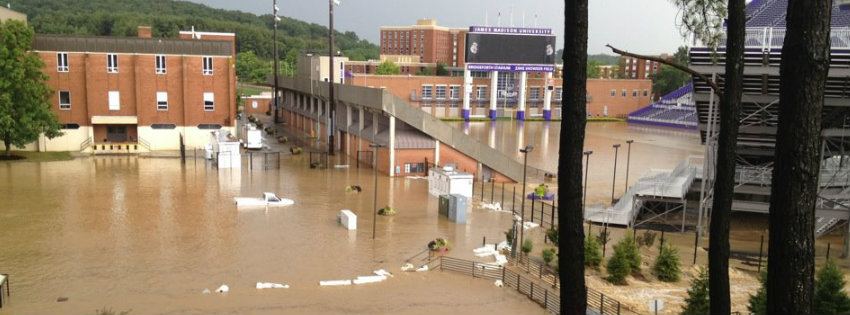
You don’t have to live in a high-risk area to be at risk for floods
Flooding is the nation’s most common natural disaster, particularly for those who live in a low-lying area, near water or downstream from a dam. Even a very small stream or dry creek bed can overflow and create flooding.
Get your roommates and family ready for a flood
- Listen to local TV or radio for weather watches and warnings.
- Learn the terms:
- Flood Watch or Flash Flood Watch: Issued when conditions are favorable for flooding or flash flooding. It does not mean that flooding or flash flooding will occur, but it is possible.
- Flood Warning: Issued when flooding is imminent or occurring.
- Flash Flood Warning: Issued when flash flooding is imminent or occurring.
- Be ready to evacuate. Don’t return to your home, apartment or dorm until officials say it is safe. Use common sense and caution
- If you see water rising quickly or a moving wall of mud and debris, immediately move to higher ground.
- Do not walk through moving water. Six inches of water can knock a person off their feet.
- Remember that after a flood, it could be hours or days before emergency personnel are able to reach you.
Know the road conditions before you leave
- Do not drive into flooded areas. Many cars will start to float in as little as 1 foot of water. If your vehicle becomes surrounded by rising water, get out quickly and move to higher ground.
- Flood water might cut off access to roads. Be ready to stay where you are until floodwaters recede.
- Know the road conditions before you leave. Check the website, 511 Virginia, or call 511 for real-time traffic information and road conditions.
- The Virginia Department of Transportation offers the latest road reports and closures during a major flooding event.
Get your apartment, dorm or home ready for a flood
- Homeowner’s insurance does not cover flood damage. About 75 percent of flood claims come from low to moderate flood-risk areas, but only 4.3 percent of Virginia homes in those areas are covered by flood insurance. Find out more at FloodSmart.gov.
- Elevate the furnace, water heater, and electric panel in your home if you live in an area that has a high flood risk.
- Consider installing check valves to stop floodwater from backing up into the drains of your home.
- Unplug electrical appliances and move them to higher levels, if possible. Do not touch an electric appliance if you are wet or standing in water.
- Construct barriers to stop floodwater from entering the building, and seal walls in basements with waterproofing compounds.
- If time allows, bring in outside furniture and move your valuables to higher places in your home.
Areas of Campus to Avoid During a Flood
- The “C-1” commuter parking lot located off of Grace Street, across from the Facilities Management complex.
- Areas on either side of the tributary of Black’s Run running parallel to and between Dukes Drive and the Norfolk Southern tracks.
- The intersection of Duke and Bluestone which includes Mr. Chips Convenience Store
- The Godwin lot which includes Godwin Transit Center
- Bridgeforth Stadium area including the Plecker Athletic Center.
- Newman Lake area by Greek row.
- The tunnel under Interstate 81 connecting the east and west campuses. This is a particularly vulnerable location, especially in flash flooding, especially when the volume of water run-off is significant.
- The grassy lawn just east of Godwin Hall (when heavy volumes of water originate from the tunnel under I-81). This water eventually drains into the lake.
- The Arboretum
- Hillside Field area
